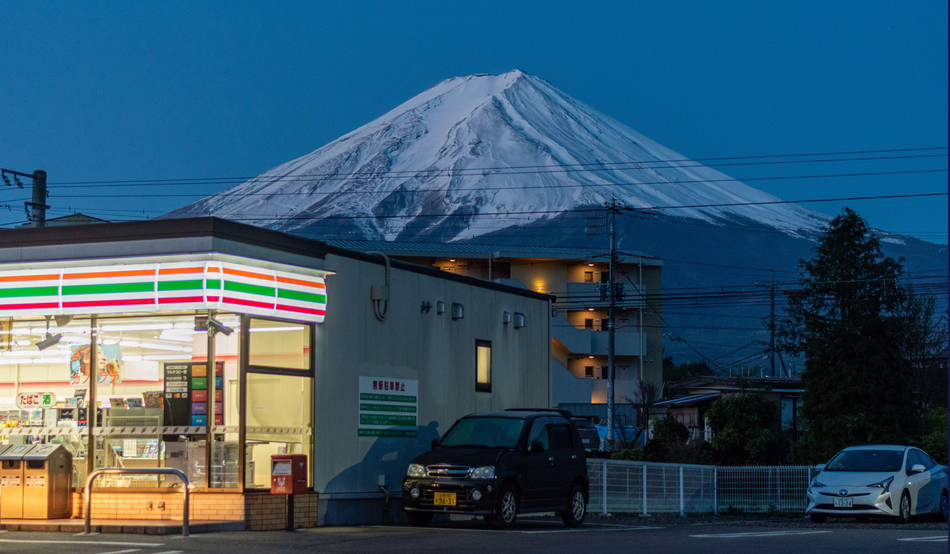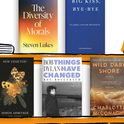When Shōmetsu Sekai (Vanishing World) hit Japan’s bookshops in 2015, its author, Sayaka Murata, was all but unknown on British shores. More Japanese books were starting to appear in English (notably Takashi Hiraide’s The Guest Cat), but translations from French and Swedish still dominated sales of foreign literature, reflecting both a longer tradition and newer appetite for mass-market Scandinavian crime fiction. Haruki Murakami was—by far—the most popular contemporary Japanese writer in translation.
What a difference a decade makes. The UK publication this spring of Vanishing World, a slim novel featuring a mysterious new town where sex is taboo and anyone—men included—can apply to be artificially inseminated, was into a very different literary landscape. Japanese titles in translation now outstrip all other languages, according to Nielsen BookScan, which measures sales of print books. The twin pillars of comfort and crime are driving the boom, with an emphasis on the former: books about cats, cafés and bookshops dominate the bestseller lists for novels in translation from Japanese, while thrillers by writers such as Keigo Higashino are perennial favourites.
More than one-third of the top 40 translated titles so far this year are by Japanese authors, according to Nielsen IQ BookData; including, yes, Murakami—but also Murata. The 45-year-old author, who lives in Tokyo, soared to global stardom in 2018 after Konbini Ningen—which won Japan’s biggest literary prize, the biannual Akutagawa, in 2016—was translated into English by Ginny Tapley Takemori as Convenience Store Woman. Readers fell equally for Keiko Furukura, Murata’s 36-year-old awkward protagonist, who has worked in the same convenience store for half her life, and for Murata herself, who also spent 15 years working behind various shop tills while writing part-time. The novel’s feminist undertones were a bonus in the #MeToo era. Sales exploded, hitting more than two million copies in 40 countries for Murata’s 10th novel in Japanese but her first for anyone reading in English.
Murata wasn’t the first female writer from Japan to strike a chord over here. Banana Yoshimoto’s seminal novella Kitchen was translated into English in 1993 by Megan Backus. And yet, the dozen or so editors, translators, academics and literary agents I’ve been speaking to over the past few months all cited Murata as the current catalyst. “The phenomenal success of Convenience Store Woman was maybe the beginning of this particular wave of Japanese books,” says Anna Kelly, an editor at Virago, which published the first English translation of Fumio Yamamoto’s The Dilemmas of Working Women this July.
The editors, translators, academics and literary agents I’ve been speaking to all cited Sayaka Murata as the current catalyst
“Yes, Convenience Store Woman was that important,” says David Boyd, associate professor of translation and Japanese studies at the University of North Carolina at Charlotte, when I ask if one book could really change an entire literary zeitgeist. “Publishers almost always stick to what they know. Until Convenience Store Woman came out, they wanted the next Murakami. Afterwards, they started asking for the next Convenience Store Woman. It took a massive success like that to convince big and small presses to really invest in contemporary Japanese fiction.”
In Murata’s gently devastating story, Keiko, a woman indifferent to her own sexuality, prompts readers to redefine their perception of normality. (In an interview last year, Murata told me she thinks normality, as decreed by society, “is a form of madness”.) That initial hit paved the way for more of Murata’s books to appear in English, work that is far darker and more intense than her early fans might imagine. “Her editors are committed to her as a writer. They are willing to bring readers the full spectrum of what she is doing instead of cherry-picking. I’m hoping that will transfer to other authors,” says Allison Markin Powell, who is best known for her translation of Hiromi Kawakami’s Strange Weather in Tokyo.
In Murata’s Earthlings (2020), all topics are fair game, from child abuse and incest to violence and cannibalism. The protagonist is a child who believes she is an alien living in a town that is a factory for human babies. It’s clever and very shocking. Life Ceremony, her 2022 short story collection, is set in a near future where anything goes. “A First-Rate Material” is a story about recycling human bones, teeth, hair and skin as materials for furniture, jewellery, clothing and wedding veils with a personal touch. In the title story, death is celebrated by eating the deceased. “They say you get better soup stock from men, don’t they?” someone remarks about a former colleague. “Why is it so horrible? Why is it a sin?” Murata said about cannibalism during a talk at the Frankfurt Book Fair in 2023, recalling her fascination with the idea when she was young. “As a child, I didn’t feel that eating human flesh would be that bad… Now I’ve been socialised, but if I hadn’t been, maybe I could prepare a soup from my father’s skeleton.” (Her father is still alive.)
Vanishing World, which was published in April by Granta in the UK and Grove Atlantic in the US, is another eye-opener that returns to familiar themes, such as the pressure on women to procreate. As with Murata’s previous novels, her prose, as rendered by Takemori, is flat and affectless. She is very matter-of-fact about the most unusual ideas, serving to amplify their oddity. “‘Just look in the dictionary. The definition of ‘incest’ is given as ‘sexual intercourse between family members, such as between husband and wife’,” is one exchange in Vanishing World, where the protagonist divorces her first husband on the grounds of assault because he tries to kiss her. Murata’s skill lies in making even the most outlandish ideas seem logical.
That said, would Vanishing World have found a publisher without Murata’s track record? After all, many Japanese publishers such as Shinchosha, home to Murakami, have long backlists of great books yet to be translated. “Had I pitched it way back when, I might have placed it and it might have sold well, but it’s certainly true that it will be hugely helped by the success of Convenience Store Woman and the fact that Murata is now a bestselling author, not to mention the current boom and changing perceptions of Japanese literature,” says Takemori.
Brian Bergstrom is Fumio Yamamoto’s translator. Alongside Murata, he highlights two other influential female Japanese writers: Yu Miri, whose Tokyo Ueno Station, translated by Morgan Giles, won the 2020 National Book Award for translated literature in the US, and Mieko Kawakami, whose Breasts and Eggs and Heaven (both translated by Sam Betts and David Boyd) were among the top 30 bestselling translated titles in the UK in 2023, according to Nielsen BookScan. “This little cluster really felt like the beginning of something big, as they were not only critical but financial successes. I’m certain this paved the way for my publication deals,” adds Bergstrom.
He has noticed how English readers relish writing by women that has an “edge”. Kawakami, Miri and Murata “are not comforting or escapist writers. They take on social issues, but more than thattheir approaches to narrative itself have a certain confrontational quality, pushing readers out of their comfort zones both thematically and formally,” he adds.
Kelly sees similarities in the approach taken by Murata and Yamamoto, who won a major literary award in 2000 for the stories in The Dilemmas of Working Women. “Both writers are intensely engaged in the relationship of the individual to society. The protagonist in Convenience Store Woman is both very ordinary and also idiosyncratic and weird, while Yamamoto also wrote about ordinary, everyday women. British readers can process their own feelings about isolation and slight weirdness through her characters.”
“Here, Which is Nowhere” is my pick from Yamamoto’s collection. It’s a poignant story about a cash-strapped mother who is sandwiched between an ungrateful teenage daughter and her own overbearing, widowed mother. Forced to find part-time work at a late-night convenience store because her husband has been “restructured”, she laments: “At this point, the banality of the humdrum married life I’d imagined would be a relief.” She has constant money worries and never gets enough sleep. As she listens to her own mother spout “her usual litany of complaints”, she wonders, “Would this be me at some point? Assaulting my daughter with a warped version of love and dependence?”
Yamamoto captures economic angst very well. Writing those stories in the 1990s, she had a head start on her western peers with stories about financial difficulties: Japan’s economy entered recession in the 1980s. “Works from Japan that evoke the atmosphere of economic downturn and precarity feel pertinent to readers outside Japan even if, as in the case with Yamamoto, they’re from over 20 years ago,” Bergstrom tells me.
The world of work is a recurring theme in women’s writing from Japan, particularly in books such as Kikuko Tsumura’s There’s No Such Thing as an Easy Job (translated by Polly Barton), Emi Yagi’s Diary of a Void (translated by David Boyd and Lucy North) and Junko Takase’s May You Have Delicious Meals (translated by Morgan Giles). Bergstrom says: “These books all examine issues related to both work and gender such as workplace sexism, generalised precarity, the conflict between work as exploitation and work as self-realisation, and so on. Yamamoto’s work thematises the particular contradictions and paradoxes facing women who see the expectations related to both love and marriage, and employment as types of traps—but what alternatives are there?” The flipside, he adds, is how the ongoing crisis creates an “opportunity, as formerly taken-for-granted life paths become less available or livable and people begin thinking about alternative ways of being happy or fulfilled.”
Yamamoto’s posthumous path to British publication (she died of cancer in 2021, aged 59) illustrates how translators are influencing literary trends: Bergstrom translated one of her stories speculatively before showing it to an agent. Others deserve even greater credit for driving the current boom. “We are seeing a lot of translator activism, which is new,” says Takemori.
In 2016, translators gathered at the London Book Fair to discuss the discrepancy between the number of titles by men being translated versus those by women. In preparing for the event, Powell was appalled to discover “well below” one-third of recently published books in translation from Japanese to English were written by women. “[This was] quite out of line with the veritable explosion of women writers on the Japanese literary scene,” she observes.
The event prompted Takemori and Powell to form a triumvirate with another colleague, Lucy North, who lives in Hastings. Strong Women, Soft Power held a symposium in Tokyo the following year. “Together we have more strength than individually,” says Takemori. North adds: “Work was being done on Japanese women authors, but it was often done by academics, whose publications tended to remain within mostly American academia, so they didn’t really reach a wider reading public.”
Other initiatives include campaigns and prizes to highlight translations. Two Japanese authors were longlisted for the most recent Warwick Prize for Women in Translation: Hiroko Oyemada’s The Factory (translated by David Boyd) and Mieko Kanai’s Mild Vertigo (translated by Polly Barton). “The quality of translations are a lot better than they used to be,” says Yukiko Tajima, a former literary agent.
More funding has helped to increase the talent pool. “About a decade or so ago, when I was starting out, we saw an increase in Japanese governmental and cultural organisations dedicating investment to nurturing a new, more diverse generation of translators from Japanese. That initial investment has had knock-on effects: in the last two years alone, the University of Bristol’s translation summer school’s Japanese workshop, which Polly Barton and I co-teach, has doubled,” says Giles.
One publisher leading the push into Japanese literature is Pushkin Press—owned and run since 2012 by Adam Freudenheim. “I wanted to explore Japanese writers who were out of print or hadn’t been translated,” says Freudenheim, explaining his decision to release several translations of Ryu Murakami, best known for his 1980 dystopian coming-of-age novel Coin Locker Babies.
A number of classic Japanese crime titles followed, notably by Seishi Yokomizo, Japan’s answer to Agatha Christie, who sold more than 55m copies of his books before his death in 1981. The Honjin Murders, featuring amateur sleuth Kosuke Kindaichi, won the first Mystery Writers of Japan Award, in 1948, but was released in English only in 2019 (translated by Louise Heal Kawai). “We have sold more than 250,000 copies of his books now,” says Freudenheim, adding: “Crime readers tend to be very avid. They want the new thing but also something familiar.”
Pushkin has scratched that new-thing itch this year with the publication of both Strange Pictures and Strange Houses by Uketsu, Japan’s bestselling author, a YouTuber who uses a pseudonym. His multimillion-selling crime series, translated into English by Jim Rion, combines text and drawings and is intended as a gateway into the literary world for manga fans. Both are intriguing, surprisingly touching mysteries that kept me—and my 13-year-old, manga-loving son—guessing.
Manga and anime still dominate global perceptions of Japanese culture, says Hiroshi Arai, senior manager in the rights department at Bungeishunjū, the publisher behind the prestigious Akutagawa prize. “Compared to these, the types of novels that are written in Japan are almost completely unknown.”
But the situation is changing. “British publishers now expect to find other great writers, not just Sayaka Murata and Mieko Kawakami. Simply put, I think Japan is a frontier with vast unexplored areas.”
Jane Lawson, deputy publisher at Doubleday, grew up in Japan, making her an “early so-called adopter of Japanese fiction in the commissioning space”. She saw The Guest Cat (Picador released Eric Selland’s English translation of Takashi Hiraide’s novel in 2014, nearly a decade after it came out in French) in a Waterstones, bought it, and loved it. “I wanted something similar.” That something turned out to be The Travelling Cat Chronicles, by Hiro Arikawa, translated by Philip Gabriel, who works with Haruki Murakami. Since its 2017 publication, this simple story of loyalty and friendship, told from the perspective of Nana the cat, has sold more than two million copies, with reviewers praising its Studio Ghibli-esque tenderness.
Cat books are a gateway to Japanese fiction, says Lawson, adding: “Booksellers come for the cat books, then dig into it for non-cat-related fiction. There are similar touchpoints: community, connection, spirituality, unsung heroes. There is relatable darkness. Grief. The cycle of life. And the cute effect.” Literal copycat titles abound, she admits. “It’s become a capitalist market. There is appetite, so let’s make hay. But eventually there will be a lot of cannibalisation. They can’t all succeed.”
For now, though, “lighter, cosier fare, often featuring cats, bookshops or cats and bookshops, is dominating frontlist sales of Japanese fiction in translation” at Waterstones, according to Matt Hennessey, the chain’s fiction buyer. Social media posts are driving sales, says Lawson. One of her biggest titles, Michiko Aoyama’s What You Are Looking For is in the Library (translated by Alison Watts), was ignored by British critics but is among Waterstones’s Japanese bestsellers. “Reviewers are looking for books with deeper themes. But whether you find these themes is totally subjective,” adds Lawson.
Nozomi Lynette Uematsu, a lecturer in Japanese studies at the University of Sheffield, is writing about the boom in the translation of Japanese women’s writing. She credits BookTok—the literature-inclined corner of the video platform TikTok—with stimulating interest among younger readers. Data from 2022, compiled by Nielsen for the Booker Prize Foundation, found that people under the age of 35 accounted for almost half of all translated fiction purchases. “Students respond well. It’s as if many stories are about their story, especially if they are about economic precarity,” says Uematsu.
People under the age of 35 account for almost half of all translated fiction purchases
Filippo Cervelli, lecturer in modern Japanese literature and popular culture at Soas, University of London, agrees, again pointing to the particular appeal of Convenience Store Woman.
“For many students, Murata’s writing advocates new ways of articulating gender and carving out your own space, no matter what society says. We have a lot of discussions about sexuality and freedom of expression.” Freedom, for Murata, often means escaping societal expectations such as getting married and giving birth, which is why her work often explores futurological, gender-equal alternatives.
A single woman is also the protagonist in one of this and last years’ biggest-selling titles for Waterstones: Butter, by Asako Yuzuki, translated by Polly Barton, which is based on a true story about a gourmet cook-turned-serial killer. As well as exposing the misogyny that cuts deep through Japanese society, Yuzuki also explores ideas around care and labour and the tensions of living as a woman in Japan. “She questions what it means for women to be free. Is it about having financial freedom, or the freedom to do what you want?” asks Uematsu.
Although Butter clocks in at 450 pages, many titles are much shorter. “Short stories and novellas are no longer a problem the way they were a decade ago,” says Pushkin’s Freudenheim. It’s partly a question of economics. “Translations are expensive, so longer books are always tricky. But we are also responding to a market where readers are more open to shorter fiction than they were.”
With brevity comes the potential for faster translations. “Where it often used to take five or 10 years for a book that won Japan’s top literary prize to reach bookshelves in the Anglosphere, if at all, now publishers are more attentive to Japanese literary trends,” says Giles.
As for the next trend? “I don’t know why, but there are quite a few medical doctors who also write excellent novels,” says Yukiko Tajima. She points to last summer’s Akutagawa prize co-winner by doctor-turned-novelist Aki Asahina, Sanshouo no Shijuku-nichi (The 49th Day of the Salamander), which is about conjoined sisters who others think are a single person. “Asahina draws on his own experiences, which are very different from [those portrayed] in cosy fiction,” Tajima adds.
“I hope that a combination of translators pursuing their own aesthetic tastes and publishers taking more note of what the buzz is in Japan will lead to a new golden era of weird, wonderful Japanese fiction in translation showcasing the many underexamined sides of its society,” says Giles. “But it will probably just be more cats.”














